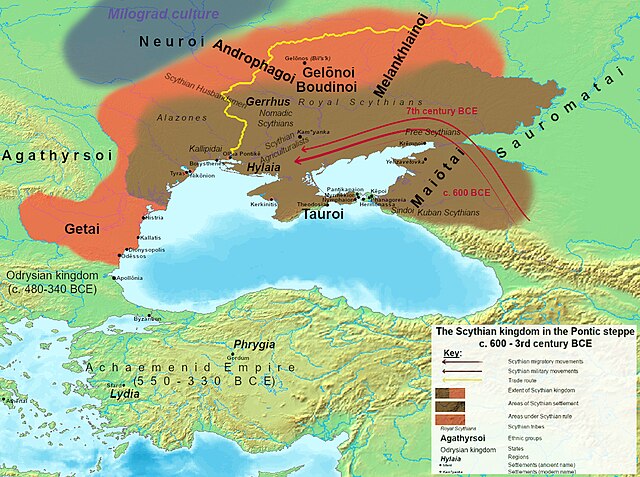Top Qs
Timeline
Chat
Perspective
Scythia
Region of Eurasia defined in antiquity From Wikipedia, the free encyclopedia
Remove ads
Scythia (UK: /ˈsɪðiə/,[1] also US: /ˈsɪθiə/[2]) or Scythica (UK: /ˈsɪðikə/, also US: /ˈsɪθikə/) was a geographic region defined in the ancient Graeco-Roman world that encompassed the Pontic steppe. It was inhabited by Scythians, an ancient Eastern Iranian equestrian nomadic people.

Remove ads
Etymology
The names Scythia and Scythica are themselves Latinisations of the Ancient Greek names Skuthia (Σκυθία) and Skuthikē (Σκυθική), which were themselves derived from the ancient Greek names for the Scythians, Skuthēs (Σκύθης) and Skuthoi (Σκύθοι), derived from the Scythian endonym *Skuδa.[3]
Geography
Summarize
Perspective
Scythia proper
The territory of the Scythian kingdom of the Pontic steppe extended from the Don river in the east to the Danube river in the west, and covered the territory of the treeless steppe immediately north of the Black Sea's coastline, which was inhabited by nomadic pastoralists, as well as the fertile black-earth forest-steppe area to the north of the treeless steppe, which was inhabited by an agricultural population.[4][5][6] The northern border of this Scythian kingdom were the deciduous woodlands, while several rivers, including Don and Dnipro, flowed southwards across this region and emptied into the Black Sea.[7]
Between the 9th and 5th centuries BC, the climate in the steppes was cool and dry, which was a catalyst for the emergence of equestrian nomadic pastoralism in the northern Pontic region. The climate became warmer and wetter during the 5th century BC, which allowed the steppe nomads to move into the steppes proper.[7]
In these favourable climatic conditions grass grew abundantly on the treeless steppe and permitted the nomadic Scythians to rear large herds of cattle and horses. The country which the Greeks named Hylaea (Ancient Greek: Υλαια, romanized: Hulaia, lit. 'the Woodland'), consisting of the region of the lower Dnipro river along the territory of what is modern-day Kherson and the valleys further north along the river, was covered with forests. Conditions in the southern lands near the shores of the Black Sea were propitious for agriculture.[4][6][8]
Before the arrival of the Scythians, this region of the Pontic Steppe was dominated by the Agathyrsi, who were nomadic Iranian people related to the Scythians. The Scythian migration pushed the Agathyrsi westwards, away from the steppes and from their original home around Lake Maeotis,[9][10] and into the Carpathian region.[11]
Beginning in the late 4th century BC, another related nomadic Iranian people, the Sarmatians, moved from the east into the Pontic steppe, where they replaced the Scythians as the dominant power of the Pontic steppe. Due to the Sarmatian incursion "Sarmatia Europea" (European Sarmatia) replaced "Scythia" as the name for the region.[12][13]

Greater Scythia
During the Hellenistic period, the use of "Scythia" by Greek and Latin speakers was extended to also cover the southern Russian steppe in general,[14] as well as the entire treeless steppe bounded by the Danubian plains in the west and the Chinese marches in the east.[7][15]
In contemporary modern scholarship, "Scythian" generally refers to the nomadic Iranian people who dominated the Pontic steppe from the 7th century BC to the 3rd century BC, and the name "Scythia" is used to describe this region of the Pontic steppe inhabited by the Scythians.[16]
Remove ads
See also
References
Sources
Further reading
External links
Wikiwand - on
Seamless Wikipedia browsing. On steroids.
Remove ads
